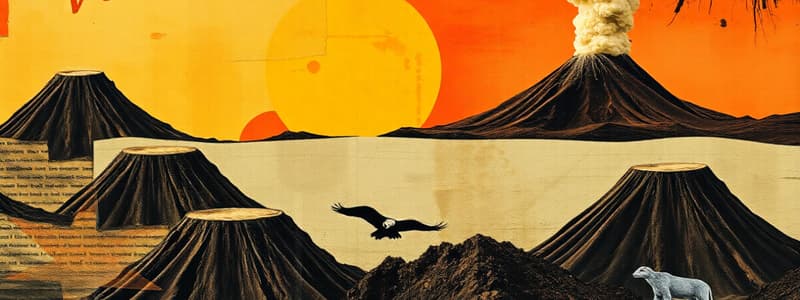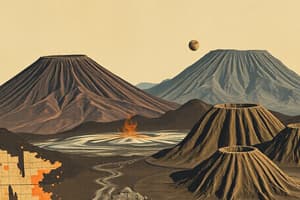Podcast
Questions and Answers
What characterizes a cinder cone volcano?
What characterizes a cinder cone volcano?
- A large depression formed from a volcanic collapse
- Flat with multiple vents and associated with explosive eruptions
- Gently sloping with a wide base and formed from lava flows
- Steep and conical in shape, built from solidified lava fragments (correct)
How do pyroclastic flows primarily occur during a volcanic eruption?
How do pyroclastic flows primarily occur during a volcanic eruption?
- By the explosive eruption of gas and ash from a volcano (correct)
- Through the slow release of lava over time
- From the continuous outpouring of lava flows
- As a result of rain mixing with volcanic ash
What is a major difference between stratovolcanoes and cinder cones?
What is a major difference between stratovolcanoes and cinder cones?
- Stratovolcanoes have steeper slopes compared to cinder cones.
- Cinder cones are primarily built from solidified lava fragments, while stratovolcanoes are composed of alternating layers. (correct)
- Cinder cones have a larger base than stratovolcanoes.
- Stratovolcanoes are formed exclusively from lava flows, unlike cinder cones.
What typically defines a caldera?
What typically defines a caldera?
What is the role of volcanic gas emissions during an eruption?
What is the role of volcanic gas emissions during an eruption?
What characterizes a shield volcano?
What characterizes a shield volcano?
Which of the following correctly describes explosive eruptions?
Which of the following correctly describes explosive eruptions?
Which type of volcano is primarily constructed from ejected lava fragments?
Which type of volcano is primarily constructed from ejected lava fragments?
What type of eruption is most likely associated with basaltic magma?
What type of eruption is most likely associated with basaltic magma?
What is a caldera?
What is a caldera?
Which volcanic feature is associated with the slow accumulation of viscous lava?
Which volcanic feature is associated with the slow accumulation of viscous lava?
What primarily affects the type of eruption a volcano will have?
What primarily affects the type of eruption a volcano will have?
Which type of magma is typically associated with explosive eruptions?
Which type of magma is typically associated with explosive eruptions?
Flashcards
What determines the type of volcanic eruption?
What determines the type of volcanic eruption?
The type of magma that a volcano erupts determines how explosive or effusive the eruption will be.
What are shield volcanoes?
What are shield volcanoes?
A shield volcano is a broad, gently sloping volcano formed by the eruption of very fluid basaltic lava, which flows for long distances.
What are pyroclastic flows?
What are pyroclastic flows?
Pyroclastic flows are rapidly moving currents of hot gas and volcanic debris that are extremely dangerous, traveling at speeds exceeding 100 km/h.
How does viscosity affect volcanic eruptions?
How does viscosity affect volcanic eruptions?
Signup and view all the flashcards
What are lahars?
What are lahars?
Signup and view all the flashcards
Shield Volcanoes
Shield Volcanoes
Signup and view all the flashcards
Cinder Cones
Cinder Cones
Signup and view all the flashcards
Composite Volcanoes (Stratovolcanoes)
Composite Volcanoes (Stratovolcanoes)
Signup and view all the flashcards
Lava Domes
Lava Domes
Signup and view all the flashcards
Calderas
Calderas
Signup and view all the flashcards
Effusive Eruptions
Effusive Eruptions
Signup and view all the flashcards
Explosive Eruptions
Explosive Eruptions
Signup and view all the flashcards
Pyroclastic Flows
Pyroclastic Flows
Signup and view all the flashcards
Study Notes
Volcano Types and Characteristics
- Volcanoes are openings in the Earth's crust through which molten rock (magma), ash, and gases erupt.
- The type of volcano depends on the viscosity (thickness) of the magma and the style of eruption.
- Different volcanic features result from varying magma compositions and eruption styles.
Types of Volcanoes
- Shield volcanoes: Characterized by broad, gently sloping sides formed by highly fluid, basaltic lava flows. These eruptions tend to be effusive, meaning they are slow and non-explosive. Mauna Loa in Hawaii is an example.
- Cinder cones: Small, steep-sided cones built from ejected fragments of lava (cinders) and volcanic bombs. These volcanoes erupt explosively. Paricutin in Mexico is a well-known example.
- Composite volcanoes (stratovolcanoes): Large, conical mountains formed by alternating layers of lava flows, ash, and tephra. They have both effusive and explosive eruptions, and are associated with more viscous magmas than shield volcanoes. Mount Fuji in Japan is an example.
- Lava domes: Rounded, steep-sided structures formed by viscous lava that piles up around the vent. These are typically associated with explosive eruptions.
- Calderas: Large depressions formed by the collapse of a volcano's summit following a massive eruption. Yellowstone Caldera is a well-known example.
Eruption Styles
- Effusive eruptions: Characterized by the slow, continuous outpouring of lava. This type is common with volcanoes that erupt basaltic magma.
- Explosive eruptions: Characterized by the violent expulsion of ash, pumice, and volcanic bombs. These often result in pyroclastic flows (fast-moving currents of hot gas and volcanic matter) and are associated with more viscous magmas.
Volcanic Landforms
- Lava flows: Molten rock that flows down the volcano's slopes.
- Ash deposits: Fine-grained material ejected into the atmosphere during eruptions.
- Pyroclastic flows: Fast-moving currents of hot gas and volcanic matter.
- Cinder deposits: Fragments of lava, formed as volcanic ejecta.
- Volcanic cones: Cone-shaped structures formed by accumulation of eruptive material.
Factors Affecting Eruption Type
- Magma viscosity: The thickness of magma directly affects the type of eruption, with viscous magmas tending to lead to explosive activity and more fluid magmas leading to effusive eruptions.
Identifying Volcanic Features
- Observing the volcano's shape, such as its steepness or gently sloping form, and the type of material being erupted can help identify its type.
- Studying the distribution of volcanic deposits, such as ash layers and lava flows, aids in understanding the style and intensity of past eruptions.
Risk Factors
- Volcanic eruptions pose significant dangers, including pyroclastic flows, lahars (volcanic mudflows), and volcanic gases, that threaten human lives and infrastructure.
- Understanding the past eruptive history of a volcano is crucial for assessing its risk.
Studying That Suits You
Use AI to generate personalized quizzes and flashcards to suit your learning preferences.




